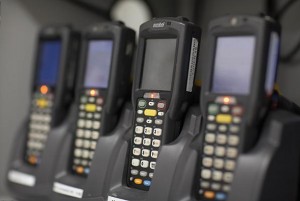Inventory App
Challenge
In October 2011 the company iQueSoft received an order to build an inventory system of medical gowns, which are used in the Scripps Research Institute (TSRI). TSRI is an American medical research facility that focuses on research in the field of basic biomedical sciences.

The necessity of the special inventory system arose due to the fact that there are more than 800 different laboratories in TSRI and an external subcontractor is employed for the cleaning, replacement, supply and delivery of gowns. As a result there was a lot of confusion such as size mismatches, the delivery of gowns to the wrong place, the loss of gowns, gowns the wear of which was not taken into account.
The order implied the software development to deal with the specialized industrial equipment, the handheld device Motorola ES 400, with an integrated bar code scanner and WiFi controller running under Windows Mobile 6.5 OS.
iQueSoft was chosen for the development of this project after the thorough search for a company with the necessary technological experience in the field of Enterprise Mobility Solutions.
Requirements
In general, within the project framework it was necessary to develop three different components – a mobile application for the Motorola ES 400 EDA, Web application for management purposes and Online Reporting System.
- Handheld application has to ensure the entry of new gowns into the system, as well carrying out of check-in and check-out during the transfer of gowns from / to the subcontractor. The application has to be compatible with OS Windows Mobile 6.5 and to make use of the on-board barcode scanner
- Web application is responsible for the administration of the system, filling in reference information and management of laboratory and staff catalogs
- Online Reporting System is a set of reports, which are available online with the basic capabilities to filter the information and export reports in various formats
Under the agreement with the customer we decided to conduct an experiment, the main aim of which was to build the Web application, not based on pure and familiar ASP.NET or ASP.NET MVC, but instead to make use of a new Ext.Net technology. Ext.Net is a technology that allows you to create amazing, convenient and interactive Web2.0 generation applications for corporate use.
Solution
Our company has a considerable experience in developing software for Enterprise Mobility Solutions in fields of Warehouse Logistics and Retail. In particular, we have repeatedly carried out the projects involving the use of specialized industrial equipment.

We worked with EDA devices, RFID readers, digital scales, micro-kiosks, cash registers, industrial label printers. It was the equipment of the following manufacturers: Motorola Solutions (former Symbol), Wincor Nixdorf, Zebra, Psion, BitaTek, Pidion, Alien, DIGI.
As there was a need for several different client applications, we decided to put the business logic layer into a separate Web Service, thus making sure that end customer’s business processes are followed strictly. We have formed the development of the Web Service business logic, mobile application and reporting system as three different phases of the project.
The development of the Web application has been divided into two steps:
- The development of our own Web UI library on Ext.NET technology, which is a set of high-level abstractions for rapid development of CRM like systems in the Web iQueSoft undertook all expenses and risks involved with this development under the agreement with the client
- The development of Web user interfaces based on the previously developed library. This development was the fourth phase of the project
While developing the project it was important to coordinate the development of three separate interdependent parts, as well as the development of the separate UI library. We achieved this by applying the continuous integration approach and short sprints.
The quality, visual appeal and interactivity with which we implemented user interfaces for the Web application deserve a special mention. In terms of the performance quality they surpass of superior to Desktop applications. Another advantage is that a user can transfer all his experience with Desktop applications on the Web. It is possible that a user, who opened a browser and ran the application, would soon forget that he is on the Web, and would continue to work, being certain, that this program is running locally on his computer.